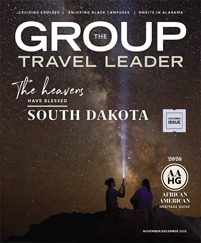In every corner of the state, Ohio will impress and possibly surprise your group.
Unexpected gems in big-city neighborhoods and quaint towns juxtapose gorgeous scenery and numerous activities for a memorable journey. Starting in Columbus and heading north to the Lake Erie region before looping back to Hocking Hills State Park, I received a warm Midwestern welcome when I toured the state last summer.
German Village, Columbus
Like many cities, Columbus has several historic neighborhoods, each with a distinctive story and culture. Just south of downtown Columbus, I stepped into a bygone era at German Village, the city’s first designated historic district. Brick cottages with slate roofs, cobblestone streets, gated gardens and window planters bursting with flowers charm all who visit. Today’s district is smaller than the original, but there are plenty of sights in its 233 acres. Schiller Park, the neighborhood’s 23-acre centerpiece, looks much as it did in 1898. Smaller homes fill the south side of the district, and elaborate Italianates and Victorians occupy the north side.
At the red-brick Meeting House, my introduction to the village started with a short video that detailed the neighborhood’s history. Afterward, local author John Clarke took me on a fascinating walking tour, sharing the history of almost every building that we passed. Step-on tours are another of his specialties. It’s all published in his new book, “German Village Stories Behind the Bricks.”
“Families came here in the 1830s, and some still live here today,” said Clarke. “This area looks much as it did 100 years ago and has several of the most celebrated restaurants in Columbus.”
Lunch at fifth-generation-owned Schmidt’s, with its German buffet and house-made sausages, was a boisterous affair. Dinner at upscale Lindey’s, one of Columbus’ most distinguished restaurants, featured a medley of tasty American dishes. Another highlight, the Book Loft ranks as the nation’s largest independent bookstore, selling thousands of titles. There is even a map to navigate the store. If it weren’t for the fascinating architecture and Clarke’s stories, I could have spent the afternoon wandering its 32 themed rooms, with floor-to-ceiling bookshelves and different music playing in each nook.
Dublin and Hilliard
Bridging the gap between Dublin, Ireland, and Dublin, Ohio, this community on the northwest side of Columbus touts a spunky Irish attitude. Downtown Dublin’s limestone buildings reflect the Old World, and boutiques and sweet shops make this a delightful spot.
I visited the establishments on the Four-Leaf Clover Scavenger Hunt, which is available for groups: Ha’penny Bridge Imports of Ireland, Our Cupcakery, TehKu Tea and the Sisters Sweet Shoppe. At Ha’penny Bridge Imports, the owner tailors talks around Irish celebrations, and Our Cupcakery offers cake-decorating classes as well as a decorate-your-own-cupcake counter.
Near downtown Dublin, many locals and visitors head to the Morgan House for dining and shopping. This former log cabin, named after famed Civil War veteran John Hunt Morgan, has seen several expansions since it was moved to its current site in 1985. A labyrinth of rooms displays Ohio-made products, gifts, clothing, gourmet food, furniture, home decor and more. The restaurant serves lunch only and easily accommodates groups. Afterward, I stopped by the Richens Timm Academy of Irish Dance to watch practice. Irish dancing is a mainstay in this neighborhood.
“By far, one of our best group experiences is Irish Dance 101,” said Amanda Mikkelson, group sales manager at the Dublin Convention and Visitors Bureau. “Owner John Timm won the Senior Men’s World Championship in Irish dancing in 1993.”
Established in 1853, the nearby town of Hilliard commemorates its beginnings at the Historic Village at Weaver Park. The village buzzes with activity as costumed docents lead tours and give demonstrations that offer a glimpse into 1800s life. Except for the museum, each original building on the three acres was moved on-site; they include a 19th-century truss bridge, a log cabin, a one-room schoolhouse, an election wagon and a caboose. Tours start in the 1855 Collwell Chapel. The museum displays vignettes of 1800s life: a barber shop, a general store and more.









